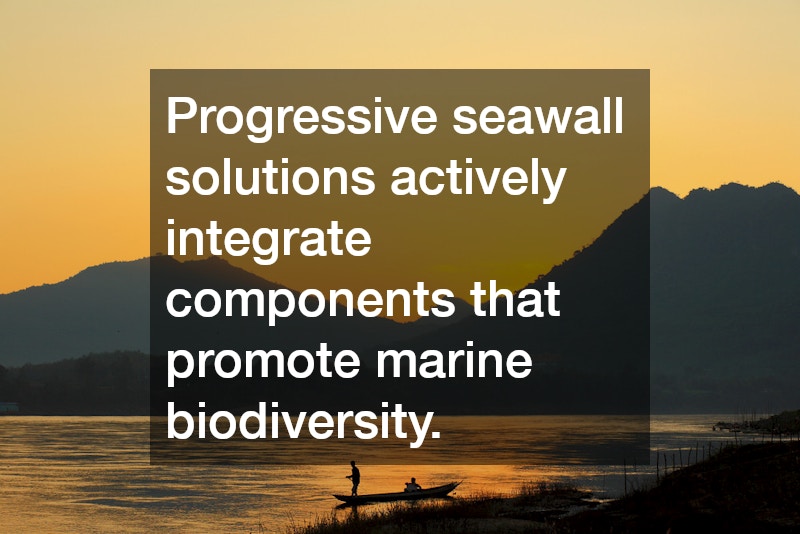Seawalls are crucial components in coastal protection, offering a defensive barrier against the relentless forces of nature such as waves, tides, and storms. Inadequately maintained seawalls can lead to catastrophic failures, resulting in significant damage to properties and potentially threatening lives. Investing in high-quality seawall services not only ensures optimal functionality and reliability but also offers considerable economic benefits in the long term by reducing the need for costly repairs and replacements.
1. What are the Benefits of Seawall Maintenance?
1.1 Prolonged Lifespan of Seawall Structures
Regular maintenance is integral to extending the lifespan of seawall structures, achieving years of additional service beyond their original expected life. This proactive approach reduces the frequency of replacements and lowers the cumulative costs associated with constructing new seawalls.
By catching and addressing minor issues early, well-maintained seawalls avoid expensive overhauls and maintain structural durability.
1.2 Prevention of Costly Damages
A well-maintained seawall is less likely to suffer catastrophic failure, thereby preventing costly damages. Without proper care, small fissures or weaknesses can develop into major structural threats that necessitate extensive repairs. Avoiding the escalation of such issues minimizes potential disruptions and keeps repair expenses manageable.
1.3 Enhanced Property Protection
Seawalls serve as the frontline defense for coastal properties against erosional forces and flooding. By investing in comprehensive upkeep, property owners optimize their protection and preemptively counter potential threats. This proactive defense reduces the financial burden of potential recovery efforts that might otherwise arise from property damage.
In addition to preserving the physical integrity of the seawall, regular maintenance ensures that adjacent properties benefit from the safeguarded protective measures. Secure seawalls function effectively to stabilize land, thereby securing the nearby urban ecosystems against encroachment by rising water levels. Enhanced local stability leads to a cumulative reduction in insurance claims and liabilities for homeowners.
The positive ripple effect of reliable property shielding extends beyond direct financial savings; it sustains property values and contributes to community-wide economic resilience. Maintaining high-functioning seawalls emphasizes a commitment to long-term safety, transforming initial investments into substantial long-term dividends. As a consequence, quality seawall services prove indispensable for robust property asset management.
2. How Do Quality Seawall Services Impact the Environment?
2.1 Minimizing Environmental Impact
Quality seawall services prioritize minimizing environmental footprints during construction and maintenance activities. Providers implement strategies that are sensitive to local marine ecosystems, maintaining a fine balance between infrastructural development and ecological preservation. This approach ensures that necessary repairs do not inadvertently contribute to environmental degradation.
The use of environmentally-conscious methods protects biodiverse marine habitats from harm, preserving important coastal ecosystems. By employing techniques that minimize sediment disturbance and prevent harmful runoff, professionals safeguard surrounding aquatic life. Such precautionary measures underline the commitment of quality service providers to sustainable development goals.
Sustainable practices in managing coastal protection confirm that economic progress and environmental health can coexist harmoniously. Through innovation and adherence to eco-friendly standards, quality seawall services demonstrate a profound respect for natural ecosystems. Their missions align with broader environmental policies emphasizing conservation and responsible resource use.
2.2 Sustainable Material Use
The choice of materials used in seawall construction significantly impacts the ecological sustainability of these structures. Companies offering quality services often prioritize the use of durable, eco-friendly materials to support long-term environmental health. This practice ensures that both construction and ongoing maintenance contribute to a net-positive ecological balance.
Utilizing sustainable resources reduces the environmental footprint associated with material production and disposal. Advanced materials boasting superior durability and resiliency decrease the need for frequent replacements, leading to diminished resource consumption over time. This intentional selection of materials aligns with overarching sustainability strategies while reinforcing structural reliability.
Sustainability extends beyond construction, influencing maintenance protocols and material reuse where applicable. Such practices lower the impact on natural habitats and reflect a commitment to responsible stewardship of coastal resources. The positive outcomes of sustainable material use are manifold, advancing both the durability of seawalls and the health of marine ecosystems.
2.3 Promoting Marine Biodiversity
Progressive seawall solutions actively integrate components that promote marine biodiversity. By designing with an ecological focus, service providers encourage diverse marine life to inhabit areas in and around seawall structures. This strategic design enhances the ecological value of the built environment, contributing to richer marine ecosystems.
Initiatives such as creating habitats within seawall structures foster a thriving marine community. This practice acknowledges the role of seawalls as more than mere protective barriers, transforming them into active participants in coastal biodiversity. These efforts assure that infrastructure development can coexist with ecological enhancement initiatives.
Promoting a diverse range of marine life within the sphere of seawall goes beyond regulatory compliance, showcasing a commitment to environmental stewardship. Service providers dedicated to fostering biodiversity recognize the mutual benefits of healthy ecosystems and well-functioning human environments. Enhanced biodiversity contributes to new opportunities for ecological interactions, supporting resilience against climate change impacts.
Investing in quality seawall services delivers enduring economic advantages by extending infrastructure lifespan, minimizing damage-related costs, and augmenting property protection. Concurrently, these services advance environmental stewardship by utilizing sustainable materials and fostering marine biodiversity. By encouraging proactive investment in high-caliber seawall services, stakeholders achieve wins not only in financial terms but also in promoting ecological health, ensuring robust coastal defense systems for future generations.

